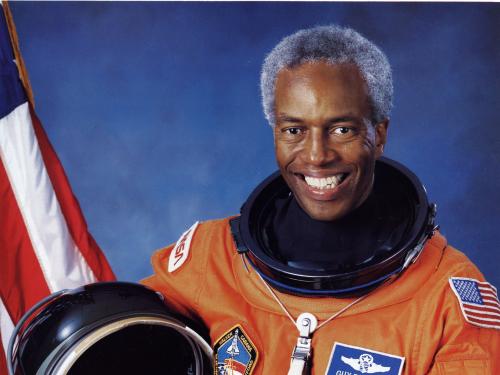
Stories of daring, stories of technological feats, stories of prevailing against the odds ... these are the stories we tell at the National Air and Space Museum. Dive in to the stories below to discover, learn, and be inspired.
Showing 41 - 50 of 78

February 07, 2018
NASA Astronaut and USAF command pilot Alvin Drew shares his reflections on a lifetime of exploring the universe.

February 01, 2018
Today marks the 15th anniversary of the Columbia disaster. Every year on this date I think about the crew of the Columbia, my students, and my most difficult day as a teacher.

February 01, 2018
For those involved or interested in human spaceflight, the last week of January is a solemn time of remembrance, as we commemorate Apollo 1 and the Space Shuttle missions Challenger and Columbia. How does our Museum deal with the memory of such tragedies?

January 19, 2018
As an astronaut, John Young (1930-2018) was one of a kind. He was the first person to fly in space six times, the first person to circle the Moon alone, the first Space Shuttle mission commander, and the first to command another Space Shuttle mission.

January 10, 2018
Bruce McCandless II (1937-2017) is immortalized in this iconic photograph of an astronaut flying solo high above Earth. He was the first human being to do a spacewalk without a safety tether linked to a spacecraft.

August 30, 2016
Guion Bluford made history on August 30, 1983 when he became the first African American in space, launching into low Earth orbit aboard the Space Shuttle Challenger. He subsequently flew aboard three additional shuttle missions, logging a total of 688 hours in space.

August 03, 2016
On this day in 2005, Discovery astronaut Stephen K. Robinson became the first person to do a spacewalk underneath a space shuttle orbiter.

January 28, 2016
The crew members of the Challenger represented a cross section of the American population in terms of race, gender, geography, background, and religion. The explosion became one of the most significant events of the 1980s, as billions around the world saw the accident on television and empathized with any one of the several crew members killed. Each has a unique story.

March 25, 2015
Every week or two we see news of another museum digitizing its collection and making it accessible online. The Smithsonian is no exception, and efforts are under way across our campus to scan artifacts, works of art, documents, and films and put them on our websites. These projects take months if not years to complete, but it is our high priority to open the museums to visitors beyond our walls, and digitization is a key part of our strategy. The National Air and Space Museum, working closely with the Smithsonian’s central Digitization Program Office, already has made a pioneering step in this direction by scanning the iconic 1903 Wright Flyer in 3D and creating a number of “tours” that enable online visitors to examine the aircraft as a whole and take detailed looks at many of its features. We have just scanned Charles Lindbergh’s Spirit of St. Louis and are preparing the auxiliary content for online access.

November 27, 2014
“Pass the turkey, please.” “Do you have room for dessert?” The elements of a traditional Thanksgiving meal are passed around in plastic pouches instead of platters and bowls, but the spirit of this holiday in space is the same as at home. Gathered around (or over!) a makeshift table, crewmates have celebrated Thanksgiving on Skylab, the Space Shuttle, the Russian Mir space station, and the International Space Station (ISS).